The AMD Radeon R9 380X Review, Feat. ASUS STRIX
by Ryan Smith on November 23, 2015 8:30 AM EST- Posted in
- GPUs
- AMD
- Radeon
- Asus
- Radeon 300
Overclocking
Finally, no review of a video card would be complete without a look at overclocking performance.
With ASUS setting the STRIX R9 380X’s factory clockspeed to 1030MHz – 60MHz ahead of AMD’s reference clock of 970MHz – ASUS is already significantly eating into the headroom available on the card, and the 1050MHz OC mode further cuts into that. We don’t have any voltage control (we can’t even read the voltage) so the card can only be overclocked as far as the Tonga GPU can go on default voltage. Meanwhile ASUS hasn’t touched the memory clockspeed at all, which should mean there’s a bit more headroom there to play with.
| ASIS STRIX R9 380X Overclocking | ||||
| ASUS STRIX R9 380X OC (Stock) | ASUS STRIX R9 380X (OC) | |||
| Boost Clock | 1030MHz | 1100MHz | ||
| Memory Clock | 5.7Gbps | 6.4Gbps | ||
| Power Limit | 100% | 115% | ||
Ultimately we were able to push the STRIX R9 380X OC from 1030MHz to 1100MHz on the GPU, a 70MHz (7%) overclock. I fully expect that Tonga could do better with more voltage – and the ASUS cooler could keep up – but at the same time it would take a bad power efficiency situation and make it worse. Otherwise memory overclocking was a bit more fruitful, as we were able to push the card from 5.7Gbps to 6.4Gbps, a 700Mbps (12%) performance increase. Note that relative to the original 7970, the R9 380X has a narrower 256-bit memory bus, so if there are any situations where GCN 1.2’s color compression technology can’t make up the difference, a memory overclock may help to close the gap.
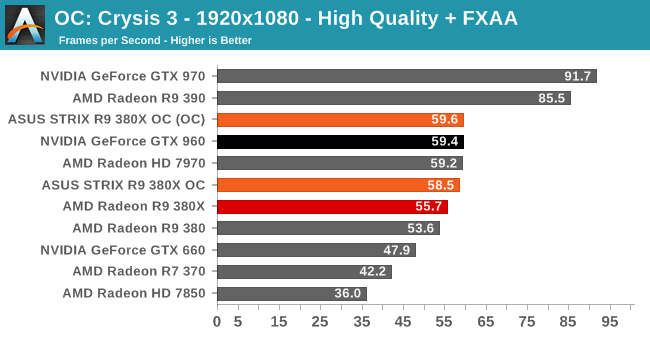
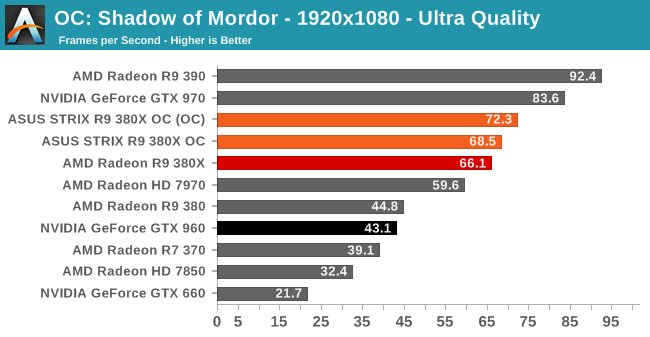
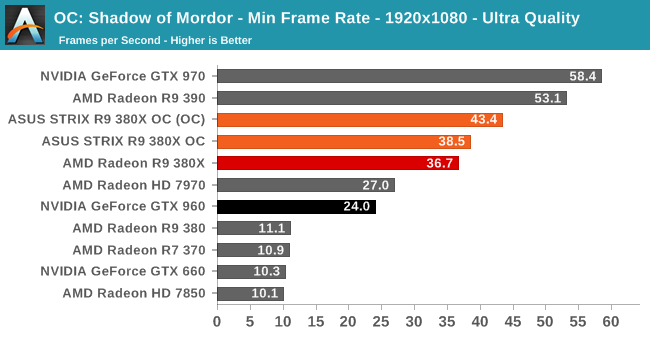
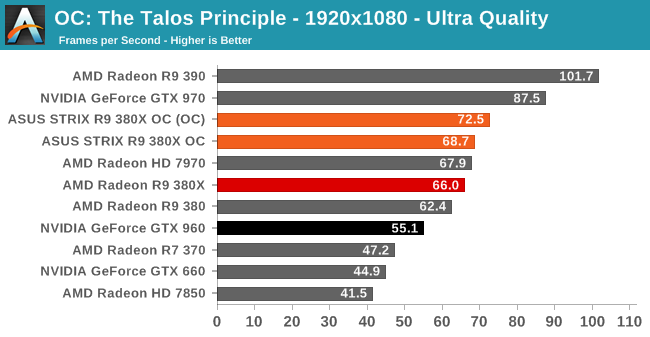
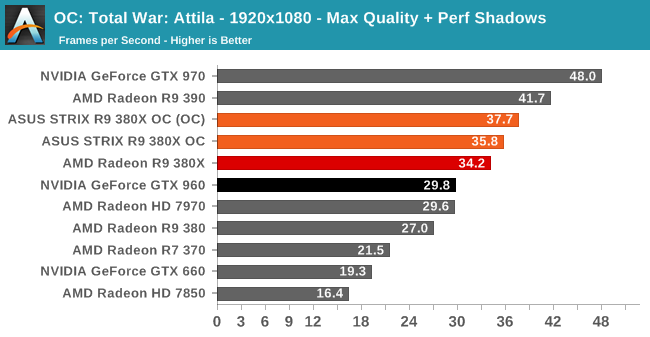
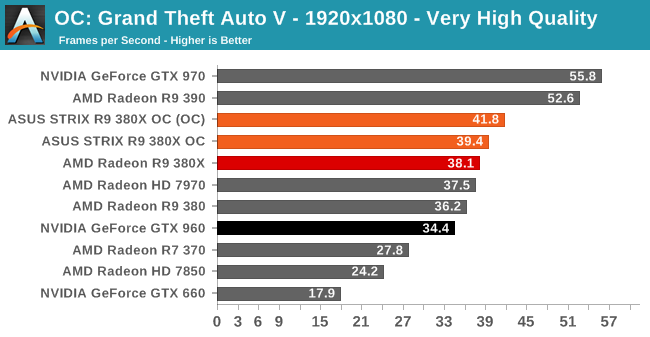
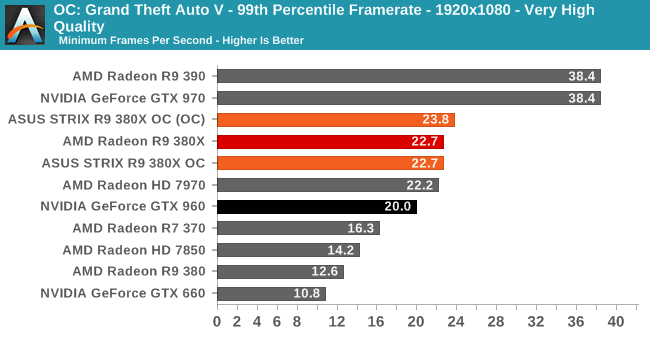
Overall overclocking is good for another 5% performance increase over the STRIX R9 380X's factory overclock. Though enough to be significant, as we guessed base upon the clockspeeds, ASUS has already tapped much of the overclocking headroom available on the card. For reference clocked cards on the other hand, assuming that they can overclock similarly well, this means they can look forward to a total of 10% or so from overclocking.
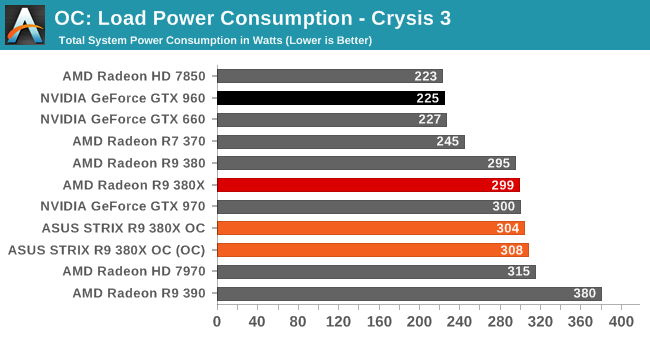
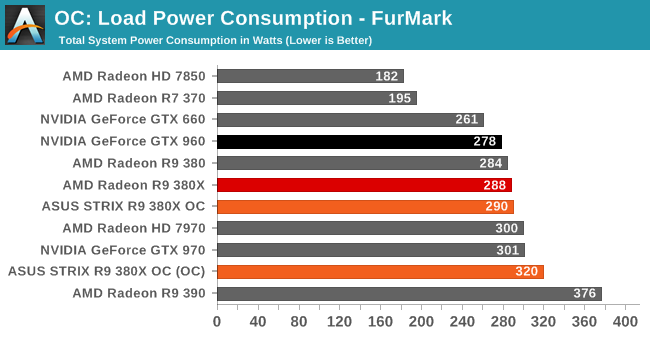
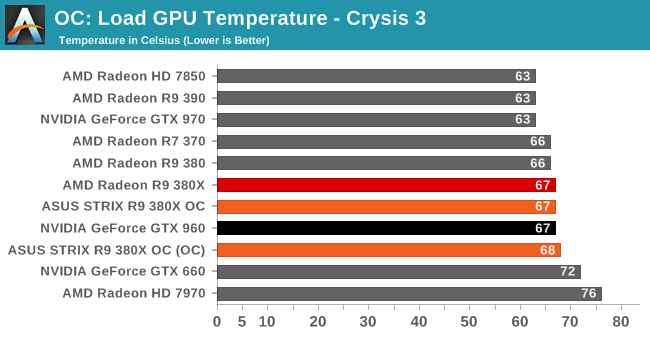
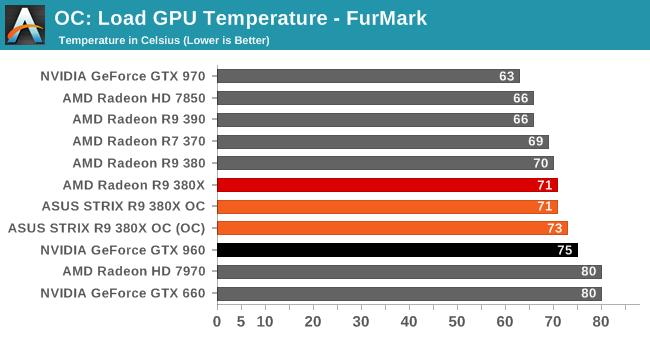
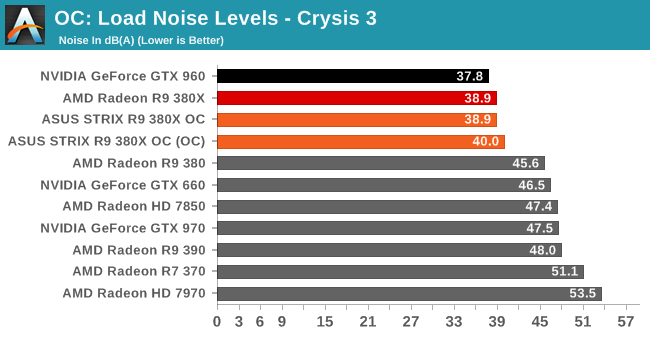
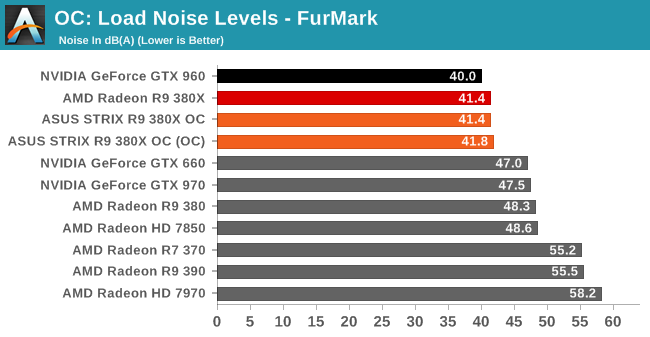
Since we can't overvolt, the power/temp/noise impact of overclocking is limited. Under gaming workloads the difference is a handful of watts and a nothing for temperature or noise. Otherwise FurMark, with the higher power target, pushes the STRIX card a bit harder, but everything still remains within reason.










101 Comments
View All Comments
Ryan Smith - Monday, November 23, 2015 - link
The power demands on the CPU are much more significant under a game than under FurMark.Also, that specific GTX 960 is an EVGA model with a ton of thermal/power headroom. So it's nowhere close to being TDP limited under Crysis.
Edit: My apologies to one of our posters. It looks like I managed to delete your post instead of replying to it...
The True Morbus - Monday, November 23, 2015 - link
So after all this time, this graphics card has the same performance as the now 2 years old GTX760?Right... I'm beginning to think the 760 was the best purchase of my life.
RussianSensation - Monday, November 23, 2015 - link
Same performance? You may need to re-check benchmarks across the web. R9 380X is more than 40% faster than a GTX760 2GB. TPU has it 43% faster at 1080P and 45% faster at 1440P:http://www.techpowerup.com/reviews/ASUS/R9_380X_St...
If you only have a 2GB version of the 760, you are also reducing texture quality in many games like Titanfall, Shadow of Mordor and have choppiness in Watch Dogs, AC Unity, Black Ops 3, and simply cannot even enable highest textures in some games like Wolfenstein NWO.
R9 380X isn't anything special when we've seen GTX970/290/290X/390 for $250-270 but it beats your card easily by 35-40%.
Laststop311 - Monday, November 23, 2015 - link
The 380x was a pointless launch. 50 dollars less you can just get the 380 which is only 10% slower. Or 50 more dollars and just get the 390 which blows the 380x away. This card targets a very narrow range and wasn't really needed imo.Makaveli - Monday, November 23, 2015 - link
I believe the difference in Shadow of Mordor between the 7970 and the 380x at 1080p may only be clockspeed and not a difference from Tahiti or Tonga!silverblue - Monday, November 23, 2015 - link
The 380X may come with extra features over the 7970, however has TrueAudio ever truly been tested? Its addition was to help reduce CPU usage and it would be a shame if it went unused in favour of the motherboard sound.silverblue - Monday, November 23, 2015 - link
Slight correction, it was to provide better effects, though I imagined that it would help a little with CPU usage anyway.Makaveli - Monday, November 23, 2015 - link
The only difference between them that counts is GCN 1.0 vs 1.2 TrueAudio has to be supported by the game and modor doesn't support it.Cryio - Monday, November 23, 2015 - link
You guys REALLY need to switch to a Skylake i7 4.5 GHz with DDR4 3000+ system for benching GPUs.That Ivy 4.2 GHz is certainly holding back AMD GPUs, core parking issues, not as fancy drivers and all.
Ryan Smith - Monday, November 23, 2015 - link
The GPU testbed is due for a refresh. We'll be upgrading to Broadwell-E in 2016 once that's available.